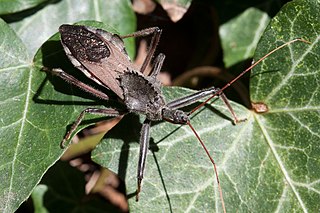Related Research Articles

The Reduviidae is a large cosmopolitan family of the suborder Heteroptera of the order Hemiptera. Among the Hemiptera and together with the Nabidae almost all species are terrestrial ambush predators; most other predatory Hemiptera are aquatic. The main examples of nonpredatory Reduviidae are some blood-sucking ectoparasites in the subfamily Triatominae. Though spectacular exceptions are known, most members of the family are fairly easily recognizable; they have a relatively narrow neck, sturdy build, and a formidable curved proboscis. Large specimens should be handled with caution, if at all, because they sometimes defend themselves with a very painful stab from the proboscis.

Rhodnius is a genus of assassin bugs in the subfamily Triatominae, and is an important vector in the spread of Chagas disease. The Rhodnius species were important models for Sir Vincent Wigglesworth's studies of insect physiology, specifically growth and development.

Arilus, or wheel bugs, is a genus of true bugs in the family Reduviidae, subfamily Harpactorinae and tribe Harpactorini. Most species are found in the Americas.
Ghilianella is a genus of true bug in the subfamily Emesinae. Fifty-eight species have been described, with a distribution from Guatemala to Brazil. The linear form of the species in this genus allow the young larvae to be carried about by the mother or perhaps the father. The larvae of the young can curl around the parent's thorax.

The Harpactorinae are a large subfamily of the Reduviidae. About 300 genera and 2,000 species worldwide have been described. Some of the species of the genera Zelus, Pselliopus, Sinea, and Apiomerus are of interest as biological pest control agents.

Stenolemus is a genus of thread-legged bug (Emesinae). Species of this genus are noted for preying on spiders.

Emesopsis is a genus of tropical bugs (Heteroptera) from the family Reduviidae. There are at least 22 described species, of which one, E. nubila, also occurs in southern Europe.
Bagauda is a genus of thread-legged bug in the Emesinae. 18 species are currently known. Many of the species of this genus are associated with caves, some exclusively so. Bagauda is synonymous with the genus Pleias Kirkaldy, 1901, but Bagauda has become more widely used. The genus is restricted to Old World tropics.
Phasmatocoris is a little-known genus of thread-legged bug (Emesinae). Fourteen species have been described, including 3 from Colombia.
Onychomesa is a little-known genus of thread-legged bug in the subfamily Emesinae. Three species have been described, one from India, Japan, and Taiwan.
Camptibia is a genus of assassin bugs in the subfamily Harpactorinae. It is reported from China. The lone species is Camptibia obscura.

Brontostoma is a neotropical genus of assassin bugs in the family Reduviidae. About 20 species have been described. These species are brightly colored with reds and oranges, and like all members of the Ectrichodiinae, specialize on millipede prey.
Agriocleptus is a small genus of assassin bugs.
Agriocoris is a monotypic genus of assassin bugs, containing a single species, Agriocoris flavipes. It is widely distributed throughout Central and South America.
Aulacogenia is a genus within the subfamily Stenopodainae of Reduviidae. 19 species have been described, including 5 from China.
Gardena insperata is a thread-legged bug species from the genus Gardena. It is found in Tajikistan and Afghanistan.
Liangcoris is a monotypic genus of assassin bugs, in the subfamily Harpactorinae, native to China, containing a single species, Liangcoris yangae.
Austrokatanga monteithi is a species of assassin bug, the sole member of its genus, in the subfamily Ectrichodiinae of Reduviidae. This species is found in Australia.
Saicella is a genus of assassin bugs endemic to Hawaii. There are currently six species in the genus. Saicella's taxonomic position is uncertain, with characters similar to both the Saicinae and Emesinae subfamilies.
Machadoella is a genus of parasitic alveolates in the phylum Apicomplexa.
References
- ↑ Dmitri Forero (2006). "New records of Reduviidae (Hemiptera: Heteroptera) from Colombia and other Neotropical countries" (PDF). Zootaxa . 1107: 1–47. Archived from the original (PDF) on 2014-03-28.